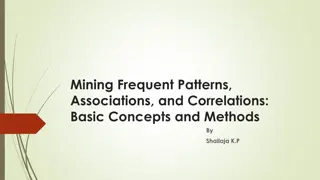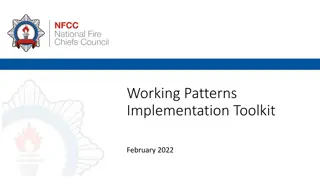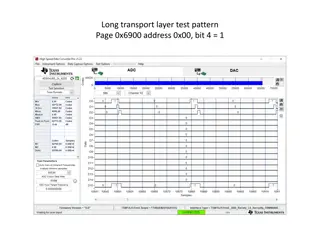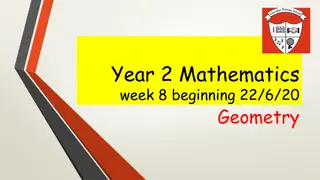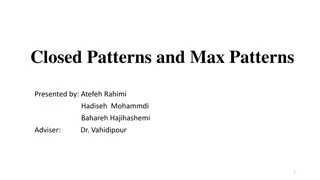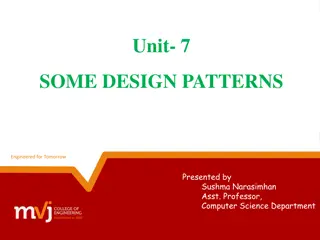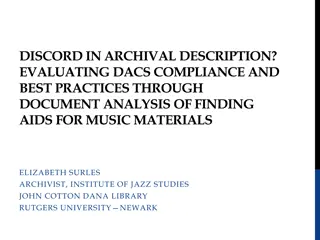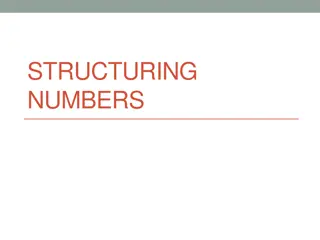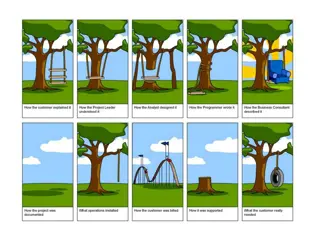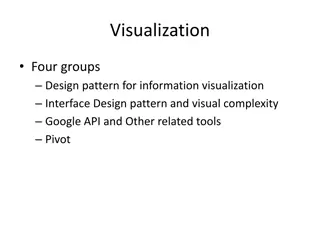Describing Patterns in Data Analysis
Dive into the world of data analysis with a focus on describing patterns, trends, and anomalies. Explore visual representations and draw insights from clustered, dispersed, evenly spread, and unevenly spread data. Uncover extremes, understand general content, and make sense of positive and negative trends. Think critically like a geographer, analyze images, and tackle tasks like thinking hexagons. Engage in argument, counterargument, and draw your overall conclusion from the information presented.
Download Presentation

Please find below an Image/Link to download the presentation.
The content on the website is provided AS IS for your information and personal use only. It may not be sold, licensed, or shared on other websites without obtaining consent from the author. Download presentation by click this link. If you encounter any issues during the download, it is possible that the publisher has removed the file from their server.
E N D
Presentation Transcript
I hope you find the resources in this template bank useful. I share these freely, but if you are able to make a donation to Education Support, it would be much appreciated. If I hadn't used them in 2016, I wouldn t be in teaching today. I have alot to thank them for. Click here to doante. Thank you.
Describing Patterns Describing Patterns GeneralContent &SpecificExamples General Content Clustered Dispersed Evenly spread Unevenly spread What is the general pattern like? Insert graph or map Are there any anomalies in the pattern? Point them out. Specific Examples What are the extremes? Highest/Most Lowest/Least Have you included data/evidence?
Describing Patterns Describing Patterns GeneralContent &SpecificExamples General Content Positive Negative What is the general trend like? Insert graph or map Are there any anomalies in the pattern? Point them out. Specific Examples What are the extremes? Highest/Most Lowest/Least Have you included data/evidence?
Think like a. Tell us what you see Human Geography Inquiry questions Natural processes Knowledgeable links Insert image
Speak like a Say what you see Physical geography? Evidence of human activity Anything unusual? Knowledgeable links Insert image
I I D D E E A A L L Inspired by @Jennnnnn_x IDEAL Identify what are the key features of the image? Describe what are the problems/processes you can see here? Explain why is this happening? INSERT IMAGE HERE Analysis insert analysis question Link insert link question
Thinking Hexagons Thinking Hexagons TASK: Cut out the hexagons as one whole shape. Each hexagon relates to the one in the middle. Your task is to explain what each hexagon shows and how it links to the middle hexagon. Level up by explaining how each hexagon links to the others it is connected to on either side. Inspired by John MItchell (@Jivespin), video tutorial here
2. Argument 3. Counterargument 4. Overall conclusion 1. Select to what extent you think . Overall, I can conclude that to _______________ extent humans .. Humans causes of the Dead Sea shrinking include On the other hand, the physical causes of the Dead Sea shrinking include . humans are the main cause of the Dead Sea shrinking This means This means Therefore Therefore Extent-o-meter
To what extent Step 1: Start with a phrase Step 2: On one hand... Step 4: Overall... Step 3: On the other hand... What is your opinion and why? To what extent? To a large extent __________________ __________________ __________________ __________________ __________________ __________________ __________________ ___________________ ___________________ ___________________ ___________________ ___________________ ___________________ ___________________ ___________________ ___________________ ___________________ ___________________ ___________________ ___________________ ___________________ ___________________ ___________________ ___________________ ___________________ ___ __________________ __________________ __________________ __________________ __________________ __________________ __________________ To some extent To a small extent
Assess Make an informed judgement Introduction Introduce the topic content from the question Paragraph 1 Make your initial argument Make a judgement (point), support with evidence, explain the evidence. Make reference to relevant case studies. Paragraph 2 Make a counterargument Make a counterpoint support with evidence, explain the evidence. Make reference to relevant case studies. Conclusion State your judgement using the evidence previously stated
Evaluate Judge from available evidence. Introduction Introduce the topic content from the question Paragraph 1 Make a judgement using evidence provided or your own knowledge. Make a point, support it with evidence and explain the evidence linking back to the question. Paragraph 2 Make an alternative point, support it with evidence and explain the evidence linking back to the question. Conclusion State your judgement using the evidence previously stated.
To what extent Judge the importance or success of (strategy, scheme, or project). Introduction Introduce the topic content from the question Paragraph 1 Make an initial judgement to the extent of the importance or success. Make a point, support it with evidence and explain the evidence linking back to the question. Make reference to relevant case studies or evidence. Paragraph 2 Make a counterpoint or another supporting point. Make a point support with evidence, explain the evidence. Make reference to relevant case studies or evidence. Conclusion State your overall judgement using the evidence previously stated.
Use evidence to support this statement To select and present information to prove or disprove something Introduction Introduce the topic content from the question Paragraph 1 Make a point to support the statement. Make a point, support with evidence quote figures and explain it linking back to the statement. Paragraph 2 Make a point to counteract the statement or to further support it. Make a point, support with evidence quote figures and explain it linking back to the statement. Conclusion State whether or not the evidence provided proves or disproves the statement.
Keep It Highlight the content to keep. Bin it Highlight the content that doesn t answer the question Build it Highlight the content that requires development Assessed by Inspired by @ploguey
ACE peer assessment (Exam classes) Exam Question/Objective of work ACCEPT Tick the work where you accept what is written. Double tick any exceptional parts of the work. CHALLENGE Something doesn t seem right? Challenge it, identify with a ? and ask a question at the end of the work. EXTEND Does something need more information? Perhaps some explanation or an example is needed? Identify with a * and ask a question or raise a point at the end of the work
Formative Feedback Sheet Name Class Task Successes Criterion A, B, C, D Insert expected outcomes related to the identified criteria / AtL Next steps Criterion A, B, C, D Insert transferrable targets for the next time students complete identified criteria / AtL
Whole class feedback PPQs and Tests Question Mark Scheme Feedback 1 2 3 4
Geog your Memory G G E O G Geographical Knowledge Earlier in the topic Insert graph Older than a month Graph analysis Inspired by @Jennnnnn_x & @_jopayne
Geog Your Memory What do you remember about What do you remember about What do you remember about What do you remember about.. 1 2 3
Knowledge Points 1 point 2 points 3 points
Retrieval Grid Insert challenge Insert challenge Insert challenge Insert challenge Insert challenge Insert challenge Insert challenge Insert challenge Insert challenge Insert challenge Insert challenge Insert challenge One Point (last lesson) Two Points (last week) Three Points (two weeks ago) Four Points (three weeks ago) Inspired by Kate Jones (@87history)
Case Study: Location: Background information Course Content: Map or relevant diagrams CASE STUDY SHEET Social Economic Environmental Political Fun Facts Other vital information
Topic - My opinion Main points List key words Facts Questions I have about the topic Words I need to define Timeline of key events
Ask better questions HAS? DID? WAS? PAST WOULD? COULD? PROBABILITY IS? DOES? PRESENT CAN? POSSIBILITY SHOULD? OPINION WILL? PREDICTION MIGHT? IMAGINATION WHAT? EVENT WHERE? PLACE WHEN? TIME WHICH? CHOICE WHO? PERSON WHY? REASON HOW? MEANING
How reliable is the source? H o w m u c h d o e s it t e ll u s ? Primary or Secondary source? What tone does it take? Objective or emotional? What is the source? Who created the source? When was it created? Who produced it? Why did they produce it? How useful? What does the source tell you? Can you relate it to your current knowledge? Is the source positive or negative? Why? Do you agree with what the source is showing? Would it be typical at the time? What does the source NOT show us that we might need to know? Limitations? Can you relate this source to another? Does it support or disagree with it?
Primary or Secondary source? What is the source? Who created the source? When was it created? Who produced it? Why did they produce it? What tone does it take? Objective or emotional? What does the source tell you? Can you relate it to your current knowledge? Does it support or disagree with your current knowledge? How useful is the source in helping you with your enquiry? What does the source NOT show us that we might need to know? Limitations? Can you relate this source to another? Does it support or disagree with it?
BUG the Question Exam Question: Command term requirements Geographical Content What do you need to do to get the marks?
Climate Graph Temperatu re ( C) 24 240 22 220 20 200 18 180 16 160 14 140 12 120 10 100 8 80 6 60 4 40 2 20 Rainfall (mm) Year Month J F M A M J J A S O N D Temp ( C) Av. Rainfall (mm) Total
Thursday, 26 November 2020 Title L/O learning objective Starter task
L/O learning objective Blue = information Green = assessment for learning Yellow = instructions Pink = feedforward Purple = stretch and challenge/extension Key terminology
L/O learning objective A Question to Ponder Insert question Key terminology
L/O learning objective To conclude Key terminology






